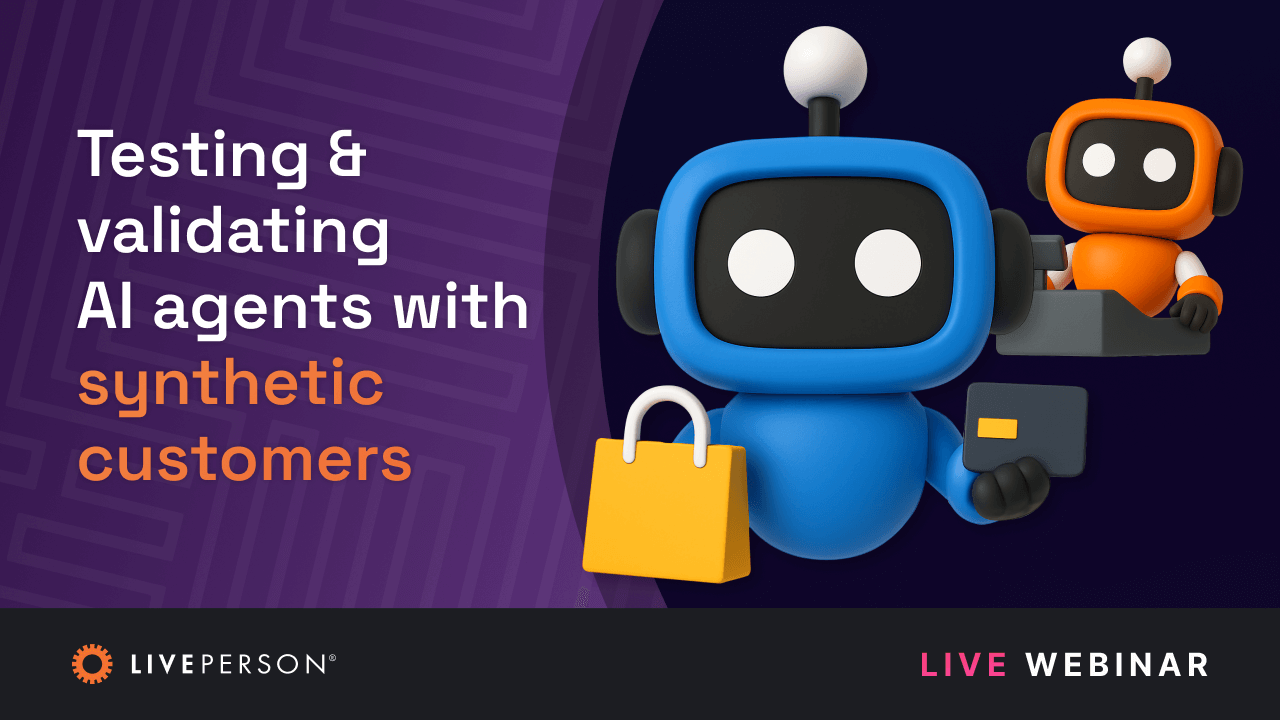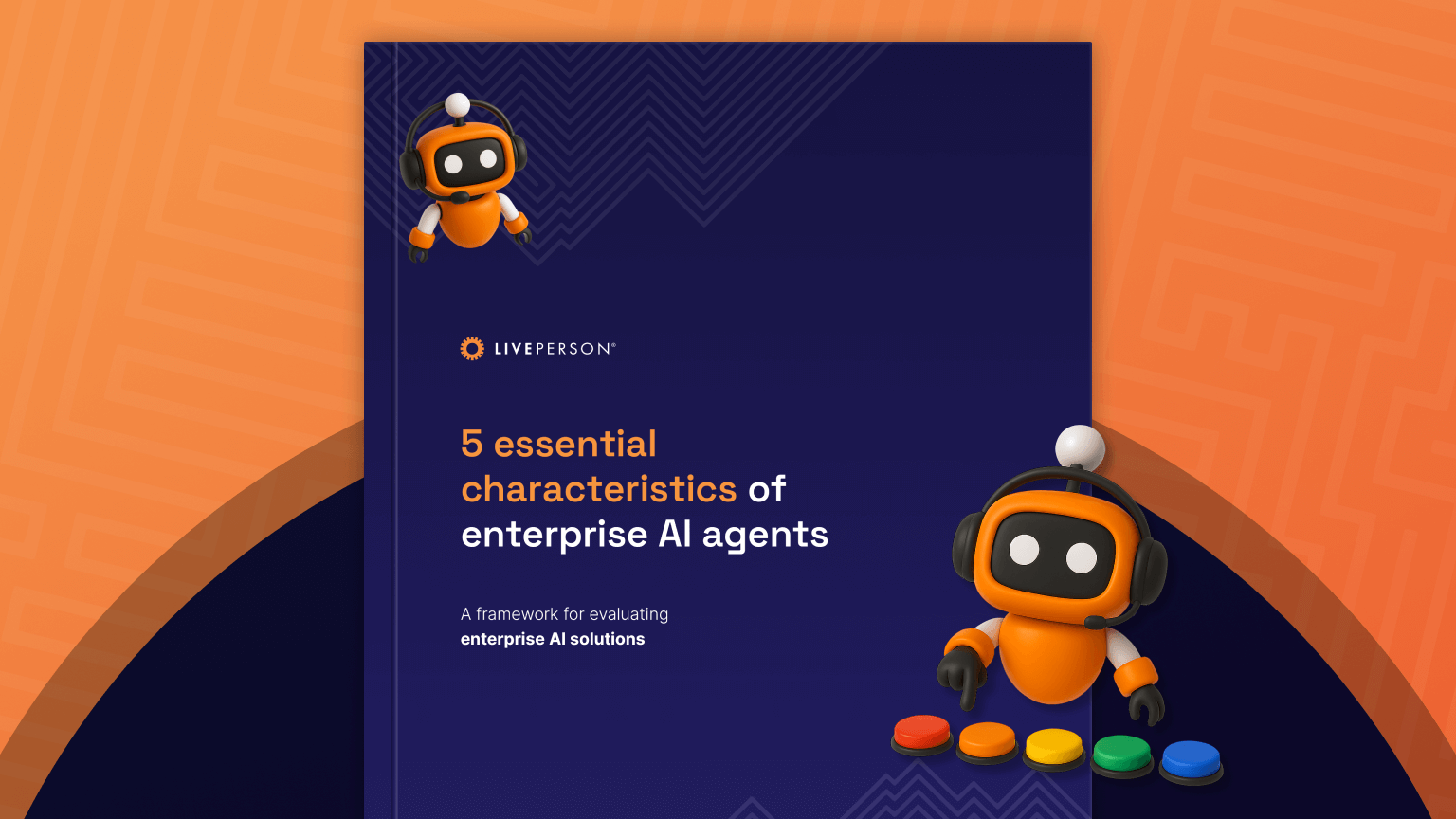article
Synthetic conversations are the new standard for responsible AI
Deploy responsible generative AI with confidence — before it meets a real customer
August 21, 2025 • 8 minutes

Enterprises today are racing to deploy AI-powered customer experiences. The pressure is understandable: early adopters are seeing significant efficiency gains, cost reductions, and improved customer satisfaction. But this rush to deployment has exposed a critical gap in how organizations validate their AI models before they interact with real customers.
Without comprehensive testing, generative AI systems face high risks of hallucinations, unexpected behavior, and brand misalignment. These aren’t just technical glitches—they’re business risks that can damage customer relationships, violate compliance requirements, and erode brand trust in ways that take months or years to repair.
The real question enterprise leaders are asking isn’t whether to deploy AI, but how to know their AI is ready before it touches a live customer interaction.
The answer lies in synthetic AI customers: a new layer of model training and validation that simulates real interactions, detects failure points, and ensures your AI systems are trustworthy before they go live.
The problem: Traditional testing falls short for generative AI development
Most enterprises approach AI testing the same way they’ve always tested software — with scripted scenarios, limited test cases, and human QA teams running through predetermined workflows. This approach worked for rules-based systems with predictable outputs, but it’s fundamentally inadequate for generative AI. Why?
- Generative AI is non-deterministic: The same input can produce different outputs, making traditional regression testing ineffective. An AI agent might give a perfect answer on Monday and generate a completely inappropriate response on Tuesday, even with identical customer queries.
- Edge cases are infinite: Unlike traditional software with finite decision trees, generative AI can encounter virtually unlimited combinations of customer inputs, contexts, and conversation flows. Human testers and training data can’t possibly cover all the scenarios where AI might fail.
- Brand voice is subjective: While you can test whether a system processes a transaction correctly, evaluating whether an AI response sounds “on-brand” or maintains appropriate tone requires nuanced judgment that’s difficult to scale with human testing alone.
- Compliance violations emerge gradually: AI models don’t just break in obvious ways. They can slowly drift toward responses that violate responsible AI principles or regulatory requirements, especially as they encounter new types of customer queries or as ethical considerations and compliance standards evolve.
The result? Many organizations discover their AI’s limitations only after deployment, when real customers experience hallucinations, receive off-brand responses, or encounter compliance violations. By then, the damage to customer relationships and brand reputation has already occurred.
Detect issues, like hallucinations and bias, before they harm your brand
You wouldn’t release software without testing for bugs. Why deploy generative AI agents without simulating edge cases first?
Synthetic customers solve this problem by acting like always-on “mystery shoppers” that continuously probe your AI systems for potential failures. Unlike human testers who work during business hours and follow predetermined scripts, synthetic AI can run thousands of conversation scenarios simultaneously, 24/7, exploring every possible interaction path.
Here’s how synthetic customer testing identifies critical risks before they reach real customers:
- Tone and brand voice validation: Synthetic customers can be programmed with your specific brand voice guidelines and trained to identify when AI responses deviate from approved messaging. They can catch subtle tone shifts that human testers might miss, especially when reviewing hundreds of conversations.
- Compliance and regulatory monitoring: Synthetic customers continuously test whether your AI adheres to industry regulations, privacy requirements, and internal policies. They can simulate scenarios where customers ask for information that should trigger specific compliance protocols, ensuring your AI responds appropriately every time.
- Accuracy and factual verification: Synthetic customers can cross-reference AI responses against your knowledge base, product catalogs, and policy documents to identify when the system provides inaccurate or outdated information. This is particularly crucial for industries where misinformation can have serious consequences.
- Escalation and handoff testing: Synthetic AI customers can simulate complex scenarios that should trigger escalation to human agents, ensuring these handoffs work smoothly and that context is preserved throughout the transition.
This safety net ensures your AI isn’t just live — it’s ready for business operations in the real world with all its unpredictable complexities.
Governance at scale starts with synthetic AI testing
Traditional AI governance often feels reactive: Teams implement guardrails after problems emerge, mitigate bias and patch vulnerabilities after they’re discovered, and update policies after compliance violations occur. This approach might work for small-scale pilots, but it breaks down when you’re trying to govern AI systems that handle thousands of customer interactions daily.
Synthetic customer testing transforms AI governance from reactive to proactive by creating a continuous validation layer that operates at the same scale as your production systems.
- Proactive risk identification: Instead of waiting for real customers to encounter problems, synthetic customers continuously probe for potential issues. They can simulate angry customers, confused customers, customers trying to manipulate the system, and customers with unusual requests — all the scenarios that reveal where your AI might fail.
- Continuous compliance validation: Regulatory requirements and internal policies evolve constantly. Synthetic customers can be updated immediately to test new compliance scenarios, ensuring your AI remains compliant as standards change without requiring extensive human re-testing.
- Scalable scenario coverage: While human testers might run through dozens of test cases, synthetic customers can explore thousands of conversation paths simultaneously. They can test every product variation, every policy exception, and every edge case that might occur in real customer interactions.
- Automated documentation: Synthetic customer testing automatically generates detailed logs of every interaction, creating comprehensive documentation for compliance audits and governance reviews. This documentation shows exactly how your AI behaves across different scenarios, providing the evidence governance teams need to enhance transparency and make informed decisions.
This goes beyond one-off piloting. Synthetic customers help transform testing into a governed, always-on risk management layer that scales with your generative AI systems.
The trust foundation for enterprise AI deployment
When your AI has passed rigorous synthetic customer validation, the entire deployment dynamic changes. Instead of cautious, limited rollouts with extensive human oversight, you can deploy with confidence, knowing your systems have been thoroughly tested against realistic scenarios.
Organizations implementing synthetic customer testing are experiencing fundamental shifts in how they approach AI deployment:
- Faster time to market: Teams can move from pilot to production in weeks rather than months because they’ve already validated their AI agents against thousands of scenarios. There’s no need for extended real-world testing periods when synthetic AI testing has already identified and resolved potential issues.
- Reduced post-launch escalations: By anticipating failure points during testing, organizations dramatically reduce the number of customer interactions that require human intervention. This means smoother customer experiences and more efficient operations from day one.
- Higher confidence in scaling: When leadership knows the AI has been thoroughly tested, they’re more willing to expand its use across additional channels, customer segments, and use cases. Synthetic testing provides the evidence needed to justify broader AI investments.
- Protected brand reputation: Perhaps most importantly, synthetic customer testing helps organizations avoid the brand damage that comes from AI failures in public customer interactions. Every hallucination caught in testing is a potential brand crisis avoided.
- Improved human agent experience: When AI systems are properly validated, human agents spend less time cleaning up AI mistakes and more time handling genuinely complex customer needs. This leads to better job satisfaction and more effective human-AI collaboration.
What synthetic customers reveal that traditional metrics miss
Most AI evaluation focuses on technical metrics: accuracy scores, response times, and completion rates. These metrics are important, but they don’t capture the full picture of how AI performs in real customer interactions.
Synthetic customers reveal the gaps that traditional metrics miss:
- Contextual appropriateness: An AI might provide technically accurate information but in a tone that’s completely inappropriate for the customer’s emotional state. Synthetic customers can identify these mismatches by simulating customers with different emotional contexts and expectations.
- Conversation flow coherence: Technical metrics might show that each individual AI response is accurate, but synthetic customers can identify when the overall conversation doesn’t make sense or when the AI loses track of context across multiple exchanges.
- Edge case handling: Traditional testing focuses on common scenarios, but synthetic customers excel at exploring the unusual situations where AI systems are most likely to fail. They can simulate customers with complex requests, contradictory information, or unusual communication styles.
- Brand consistency across channels: If your AI operates across multiple channels—chat, email, voice — synthetic customers can ensure it maintains consistent brand voice and behavior regardless of the interaction medium.
- Regulatory compliance in context: While you might test individual compliance scenarios, synthetic customers can identify compliance violations that only emerge in complex, multi-turn conversations where context and intent become ambiguous.
The competitive advantage of proactive AI validation
Organizations that implement synthetic customer testing don’t just reduce risks — they gain competitive advantages that compound over time.
- Market leadership through reliability: While competitors deal with AI failures and brand damage, organizations with robust synthetic testing can confidently promote their AI capabilities, knowing they can deliver consistent experiences.
- Faster innovation cycles: When you have confidence in your testing framework, you can experiment with new AI capabilities more aggressively. Synthetic customers allow you to validate innovations quickly without risking customer relationships.
- Regulatory readiness: As AI regulation continues evolving, organizations with comprehensive synthetic testing are better positioned to demonstrate compliance and adapt to new requirements. They have the documentation and validation frameworks that regulators will likely require.
- Customer trust as a differentiator: In markets where AI failures are becoming more visible, the ability to consistently deliver reliable AI experiences becomes a significant competitive advantage. Customers increasingly prefer brands they can trust to handle AI interactions appropriately.
Your next step: Join our webinar
The future of trustworthy enterprise AI starts with synthetic customers. The organizations that implement comprehensive synthetic testing now will have significant advantages as AI becomes more central to customer experience strategies.
In our upcoming webinar on August 26, LivePerson will demonstrate exactly how leading retailers and service brands are leveraging synthetic customer scenarios to build safer, more reliable AI systems. You’ll see real examples of how synthetic testing identifies risks that traditional validation methods miss, and learn practical approaches for implementing synthetic customer testing in your own organization.
Summary: The foundation for scalable AI trust
Synthetic customers represent the next essential layer in enterprise AI maturity. They help organizations test smarter, govern consistently, and scale safely. This isn’t just about avoiding AI failures — it’s about building the trust foundation that makes ambitious AI deployments possible.
The question isn’t whether your AI will encounter edge cases and unexpected scenarios. The question is whether you’ll discover and address these challenges during synthetic AI testing or during real customer interactions.
That’s how generative AI becomes trustworthy AI.




